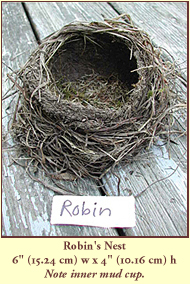|
 Everyone
loves the Robin, the harbinger of spring. A hardy member of the
Thrush family, Robins can be seen foraging for worms and grubs
on suburban lawns and urban parks all over North America. They
also eat berries. Robins build a mud and grass nest, usually
on tree branches, but they also will nest on window sills, under
decks, and even on ladders. Adult males are territorial in breeding
season, and will attack their reflection in windows (see Myths & Misconceptions
for more information about this phenomenon and what to do about
it). Everyone
loves the Robin, the harbinger of spring. A hardy member of the
Thrush family, Robins can be seen foraging for worms and grubs
on suburban lawns and urban parks all over North America. They
also eat berries. Robins build a mud and grass nest, usually
on tree branches, but they also will nest on window sills, under
decks, and even on ladders. Adult males are territorial in breeding
season, and will attack their reflection in windows (see Myths & Misconceptions
for more information about this phenomenon and what to do about
it).
The American Robin is frequently predated by cats and poisoned
by lawn chemicals. More Robins than any other species come to
us for help.
Did you know that those white grubs that might be eating
up your lawn are a staple in the diet of baby Robins? While a
couple of commercial pesticides are designed to target only the
grubs in your lawn, they can still be very harmful when ingested
by birds, especially egg-laying mothers and developing babies.
Remember, an adult Robin cannot tell if a grub or earthworm has
been contaminated with a pesticide before swallowing it or feeding
it to a baby.
We understand that nobody likes dead, brown patches of
lawn. However, there are highly effective alternatives to the
nasty pesticides often used to save the grass at the expense
of wildlife. Alternatives include beneficial nematodes and milky
spore. You can find them at many nurseries which cater to organic
gardeners. Here are some links to start you off:
American Natural Products Co.: http://www.americanatural.com
Arbico: http://www.arbico.com
Extremely Green: http://www.extremelygreen.com
Gardener's Supply Company: http://www.gardeners.com
Home Harvest: http://homeharvest.com |